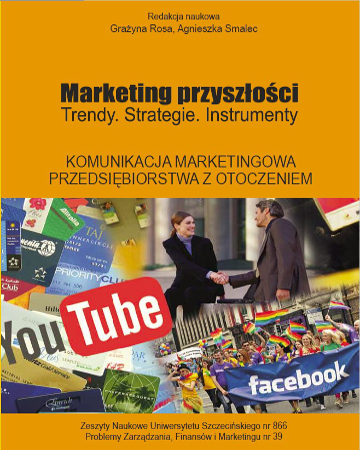
ISSN: 1509-0507
eISSN: 2353-2874
OAI
DOI: 10.18276/pzfm.2015.39-11



Issue archive /
ZN 866 PZFiM nr 39
Kreatywność w marketingu produktów sektora przemysłów kreatywnych
(Creativity in the Product Marketing of the Cultural and Creative Industry)
| Authors: |
Sławomir
Kotylak
Uniwersytet Zielonogórski |
| Keywords: | creative thinking creativeness product marketing cultural and creative industry |
| Data publikacji całości: | 2015 |
| Page range: | 10 (133-142) |
Abstract
A creative approach and seeking new, innovative solutions are features accompanying for desire of development. It is possible to state that ideas always have been a driving motor of the civilization. It happens today, in the postindustrial age as well. The contemporary development of modern economies is being identified with limiting the physical labor in the pure figure for the works based on the creativity and on the knowledge with the automation of processes. In the paper the author tries to answer the question if products and services offered by the creative industries sector - owning element of the creativity in themselves - require creative marketing. For the purposes of the study such research approaches were applied as: functional approach, methodology of the functional analysis, comparative analysis, expert approach, benchmarking. The main conclusion being an element of conducted analysis is included in the statement that the most creative product or the service requires a very creative marketing, because "way of serving the dish should not be worse than its refinement".
Download file
Article file
Bibliography
| 1. | Analiza potrzeb i rozwoju przemysłów kreatywnych, Raport Ecorys na zlecenie Ministerstwa Gospodarki, Warszawa 2009. |
| 2. | Creative economy report 2010: a feasible development option, Embargo, New York 2010. |
| 3. | Czaplewski M., E-biznes jako kierunek doskonalenia usług ubezpieczeń gospodarczych, Polskie Towarzystwo Ekonomiczne, Szczecin 2007. |
| 4. | Drucker P.F., The practice of management, Harper Collins, New York 1959. |
| 5. | Flew T., Beyond ad hocery: defining creative industries, artykuł zaprezentowany na konferencji Cultural Sites, Cultural Theory, Cultural Policy, The 2nd International Conference on Cultural Policy Research, Welington, New Zealand, 23–26.01.2002, http://eprints.qut.edu.au/256/1/Flew_beyond.pdf. |
| 6. | Florida R., Narodziny klasy kreatywnej, Narodowe Centrum Kultury, Warszawa 2010. |
| 7. | Florida R., Cities and the creative class, Routledge, New York 2005. |
| 8. | Kasprzak R., 1+1=3! Wywiad z dr Rafałem Kasprzakiem, w: Creative Poland – Partnerstwo na Rzecz Rozwoju Polskiego Przemysłu Kreatywnego, http://purpose.com.pl/purpose_files/File/Newsletter-2013-CreativePoland.pdf. |
| 9. | Kotylak S., Analiza wybranych segmentów branży elektronicznej rozrywki jako elementów rozwoju przemysłu kreatywnego w Polsce, w: Cyfryzacja i wirtualizacja gospodarki, red. M. Pluciński, Zeszyty Naukowe Uniwersytetu Szczecińskiego nr 852, Ekonomiczne Problemy Usług nr 117, Wyd. Naukowe Uniwersytetu Szczecińskiego, Szczecin 2015. |
| 10. | Kuczera K., Ewolucja pojęcia wirtualności, „Ekonomika i Organizacja Przedsiębiorstwa” 2011, nr 9. |
| 11. | Lewandowski P., Mućk J., Skrok Ł., Znaczenie gospodarcze sektora kultury, Instytut Badań Kulturalnych, Warszawa 2010. |